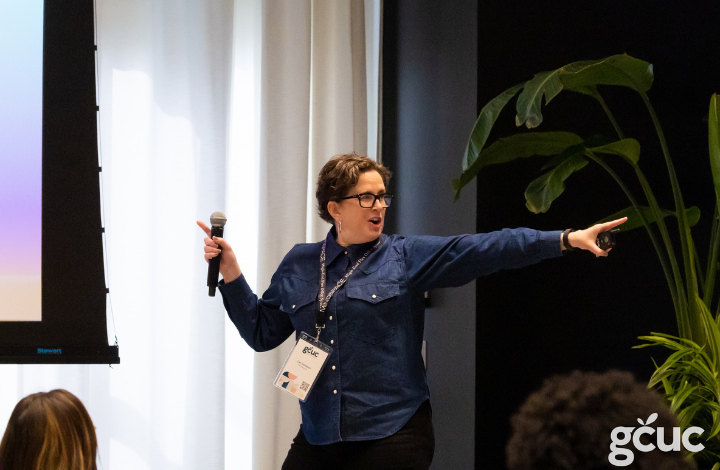When insiders talk about the coworking industry we talk about its staggering growth and rapid evolution from a small movement into a global phenomenon.
But, in real life, I still find myself describing what coworking is on an almost daily basis. I find it a bit tricky to distill all the awesomeness of coworking into a few bite-size pieces.
To find the best ways to educate people who aren’t familiar with coworking about how transformative it can be on both a personal and professional level, I reached out to the experts: coworking space operators and professionals. Here’s what I found:
Brian Pierce, Creating in Cahoots
Coworking is about community, so make sure you are involved with yours. Chamber of Commerce, networking meetings and local niche gatherings are great places to get the word out. But be prepared for the glazed stare of someone who has no idea what you mean when you use the word ‘coworking’. Once they seem interested, getting them into your space is important. That way they can see ‘coworking’ first-hand.
I have seen that glazed stare too often of late, so we’ve had to think fast and be active.
Jamie Russo, Ennerspace Coworking, Global Workspace Association
Open your space to host community events as often as you can given resource constraints. Getting community members into the space is the best way for them to see the magic happen. In Chicago, we hosted one community event a month as a way to give back and to engage. We also hosted free coworking Friday and we’d try to line it up with a happy hour or lunch and learn to give guests a more facilitated opportunity to interact with members.
Iris Kavanagh, Coworking with Iris
There are different ways to educate, depending on the person being educated. I’ve found the gym analogy to be the one people get the quickest: “We’re like a gym for people who need to work.” People join a gym because they need a place to workout, but they don’t need, and most can’t afford, to own the workout equipment and have it take up space 24 hours a day.
Small businesses and freelancers need a place to work but don’t need it full time, and might not be able to afford a full-service office at a 3-5 year lease. Just like a gym, a coworking space sells membership in the office space so that people can work here when it’s best for them, have access to a fully appointed office space, take advantage of the collective buying power of space and amenities.
The other is focused on people and usually involves a more literal telling of the history of telecommuting and coworking, dating back to the days when the internet was born and we were all promised awesome telecommuting experiences, which turned out to be lonely and isolating, then moving to coffee shops, then to jellies and finally to coworking.
Another thing I find incredibly helpful is to hand out physical day passes to people and invite them to come in and work for a day to see what it feels like. It’s always fun to see the moment people get it!
Coworking space operators: Help welcome new members to your space with the free guide, 15 Must-Do’s Your First Month in a Coworking Space. Download now.
Kay Transtrum, CO+HOOTS
I 100% agree with Jamie Russo on hosting community events. Also do an intro speech when other companies host events, as well.
Ask questions to understand what it is that [people] do. If you’re surrounded by a bunch of designers, talk about how working in a coworking space helps connect them with developers and positions them to take on big clients and work together.
Josh Rencher, Ironfire
I think it’s important for local operators to point out how they differentiate from consumer coworking (WeWork) and wannabe coworking (Regus), since those have the scale and exposure to be at the top of most people’s minds when they hear “coworking” for the first time. How you do this will vary from one local space to the next, of course, but the purpose is to get ahead of prejudice and presumption by reminding people that coworking comes in many flavors to suit different tastes and needs.
Chris Cooley, The Coworking Consultant
I’ve been part of launching a couple coworks in small/rural cities and have found the best way to spread awareness is to:
1. Educate a team of people/supporters by getting them all in a room together and making sure they are talking to community members using a VERY consistent message
2. Go on as many local media outlets as possible: radio, paper, and TV news
3. Host an open house and give tours every 15 mins or so.
Trevor Twining, trevortwining.me, Cowork Niagara
This might seem crass, but nobody cares about our industry, and they shouldn’t have to. The stories that you need to tell are about what you do for your members. Who are your members? What do they do? How does belonging to your space improve that? Look for those stories.
We participate with our local Chamber of Commerce by advocating with them on issues that matter to freelancers and single-person businesses. We actively tell stories that resonate with the memberships of both groups.
Our local economic development officers understand the impact that our space has on the city and region/county, and are also starting to understand how important the indy workforce is to the economic health of our community. We built that understanding through stories.
We support the local tech, writing, and graphic design communities by hosting meetup events. Those people, who are not all members, see how we support and encourage their personal and professional passions. The story is found in our shared interests.
There’s a bunch of other communities not mentioned here, but the approach is the same; we find stories that resonate with them, and then get involved where it makes sense. If it doesn’t, then we just don’t pay attention to them.
Jen Anderson, Meshwork
Go to nearby apartment buildings, befriend the manager, then ask to host a lunch for the tenants. Hang flyers a few days before to make tenants aware and then provide them with lunch. You get to meet people who are working from home, tell them about your space and coworking in general, and invite them to come in to try it out.
Get people in your space anyway you can. Once people are in and they see the space they will be curious and want to know more. I have done art openings, live music showcases, hosted parties for companies (outside of my members), offered free yoga classes to the surrounding community…again any way to get people in the space. Even if they didn’t need coworking, most of the time they knew someone who would be interested.
Do grassroots marketing by going out and getting into the community. Go to relevant Meetup groups and let them know who you are. I went to flea markets, festivals, music [events] and just talked to as many people as I could.
Bernie J. Mitchell, berniejmitchell.com, @WorkHubs
We have a food sharing fridge which we are trying to connect with the very local area. We need to put more work into it, with both our members and the shops and restaurants nearby to make it work, but it is a good exercise.
Coworking space operators: Get industry insights, resources and content tips sent to you every Thursday. Subscribe to the Coworking Out Loud Newsletter.
Related Posts
Should You Join a Coworking Space? [a flowchart]
The Coworking Video that’s Making Everyone Cry
An Open Letter to GCUC






